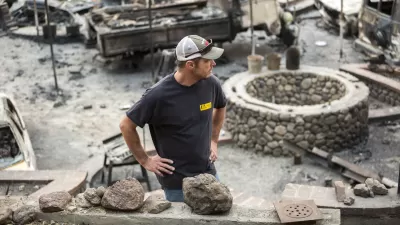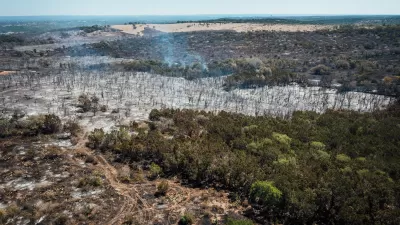Houses that aren't vulnerable to embers blowing in the wind, could save the government and homeowners millions.

Fire damage can seem random. Sometimes houses very close to each other suffer very different consequences from wildfires. Fire expert Jack Cohen encountered the kinds of hazard presented by building materials while investigating ways to combat the spread of wildfires. "People were calling in about houses on fire long before the fire front ever reached their neighborhoods," 99 Percent Invisible reports. It turned out the culprit behind these burning homes were embers carried by the winds landing on flammable wooden shingles.
While not using a flammable housing material would seem to be common sense, Cohen was able to codify the impact of design choices. Cohen's research lead to the conclusion that more emphasis should be put on building fire-resistant properties and less on fighting fires.
"In other words, if structures near fire-prone areas were designed and maintained to withstand fire, we might not need to fight some wildfires at all," 99 Percent Invisible reports. Cohen's argument is further bolstered by the sometimes counterproductive outcomes of putting out wildfires. Because where forests that have not had a burn for many years sometimes become tinder boxes of flammable material, meaning sometimes it would be better to allow a controlled burn to take place than to fight all fires.
"Last year, the federal government spent more than 2 billion dollars fighting fires and just a small fraction of that on prevention and mitigation efforts," 99 Percent Invisible writes. Shifting some of those resources might improve safety for people and property.
FULL STORY: Built to Burn

Alabama: Trump Terminates Settlements for Black Communities Harmed By Raw Sewage
Trump deemed the landmark civil rights agreement “illegal DEI and environmental justice policy.”

Planetizen Federal Action Tracker
A weekly monitor of how Trump’s orders and actions are impacting planners and planning in America.

The 120 Year Old Tiny Home Villages That Sheltered San Francisco’s Earthquake Refugees
More than a century ago, San Francisco mobilized to house thousands of residents displaced by the 1906 earthquake. Could their strategy offer a model for the present?

In Both Crashes and Crime, Public Transportation is Far Safer than Driving
Contrary to popular assumptions, public transportation has far lower crash and crime rates than automobile travel. For safer communities, improve and encourage transit travel.

Report: Zoning Reforms Should Complement Nashville’s Ambitious Transit Plan
Without reform, restrictive zoning codes will limit the impact of the city’s planned transit expansion and could exclude some of the residents who depend on transit the most.

Judge Orders Release of Frozen IRA, IIJA Funding
The decision is a victory for environmental groups who charged that freezing funds for critical infrastructure and disaster response programs caused “real and irreparable harm” to communities.
Urban Design for Planners 1: Software Tools
This six-course series explores essential urban design concepts using open source software and equips planners with the tools they need to participate fully in the urban design process.
Planning for Universal Design
Learn the tools for implementing Universal Design in planning regulations.
Clanton & Associates, Inc.
Jessamine County Fiscal Court
Institute for Housing and Urban Development Studies (IHS)
City of Grandview
Harvard GSD Executive Education
Toledo-Lucas County Plan Commissions
Salt Lake City
NYU Wagner Graduate School of Public Service





























